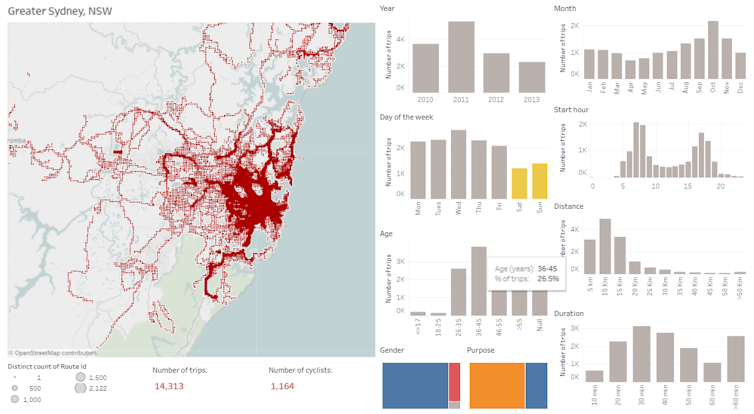
By Richard Drdla, Richard Drdla Associates, Toronto, Canada. We asked Richard, an expert on planning for affordable housing in North America, for his views on the Greater Sydney Commission’s recent policy proposals for ‘affordable rental housing targets’ . Richard compares various aspects of the GSC proposals, as set out in its October 2017 ‘Information Note’, with the corresponding ‘inclusionary zoning’ (IZ) practices used in the US.
*
The inclusionary zoning practices typically used in the US and the GSC proposals
share the same overall aim – to harness the land-use planning regulations in a
way that requires the private development industry to include at least some
affordable housing in new residential projects. However, while undoubtedly
influenced by US practices, the GSC proposals set out an approach so different
that they cannot be considered to constitute inclusionary zoning as the term is
understood in the US. Indeed, the GSC’s Information Note rightly avoids making
such a claim.
The IZ programs, while recognizably similar across the US, still vary somewhat,
especially region-by-region. Therefore, the comparison that follows is based on
what are considered to be the “best practices” used there.
Targeted incomes
The GSC policy aspires to provide housing affordable to those on ‘very-low and
low incomes’, which are respectively defined as being for 50-80% of the median
income and below 50%. Although such targets are very difficult to compare across
countries or even jurisdictions, the GSC policy and IZ programs seem to
addressing roughly the equivalent income range.
The income band targeted by the IZ programs, however, does vary somewhat
according to housing costs. Across the middle of the US, the target is generally
50-80% of median income. But in the more expensive areas on the west and east
coasts, the upper threshold is generally higher – up possibly to at least 150%, if
not more. In general, cities have higher upper thresholds than nearby suburban
communities and smaller towns. On the other hand, these programs do not
provide housing for those earning below 50%, and possibly not even for those
below 80% in more expensive areas.
Despite these numerical differences, the fundamental purpose of these programs
remains consistently the same across the US. They are all principally
directed at correcting the increasing failure of the market housing system to deliver
a sufficiently broad range of housing, especially in high-growth areas.
These programs are typically designed solely by municipalities, with the clear
intention to operate independently of upper-tier governments, and to serve housing
needs as they want to define them. As such, the programs rely on land-use
planning regulations (which are under their control), and not upon financial
subsidies (which are beyond their resources or could involve conflict with the state
and/or federal governments over priorities).
As a consequence, these programs aim to generate what is widely and commonly
called “below-market” housing. This is housing essentially for households left out
of the private housing market by the rapidly rising prices over the last 20 or more
years. On the other hand, they do not typically provide social housing, nor housing
for those in greater need like the homeless. These groups are considered beyond
the reach of such programs, and dependent on deep subsidies potentially
available only through upper-tier governments.
What does confuse this clear distinction is the many examples of developments
achieving deeper affordability by using federal/state dollars layered on top of the
reduced price or rent achieved by IZ. But overall these remain the exception
rather than the rule. The vast majority of IZ developments in the US still proceed
under the basic or “default” rules to provide “below-market” housing without any
such subsidies.
Upzoning
The proposed GSC policies will apply only to developments on newly upzoned
sites. In most US programs, by contrast, the affordable housing mandate applies to
all developments seeking approval. That includes, not only sites subject to
rezoning, but also those proceeding under the existing or “as-of-right” zoning. The
only exceptions to this are the dozen or so big city programs, where the mandate
in most (but not all) cases is applied only to rezonings.
As a general rule, the mandate in the US is applied as widely as possible to
maximize affordable housing production. Limiting IZ to rezonings in the big cities,
nevertheless, can be generally justified because nearly all st developments there
need a rezoning. On the other hand, imposing this limitation in communities where
rezoning is less prevalent would have substantially reduced the affordable housing
output.
The US experience, however, clearly shows that even “as-of-right” developments
are able to provide affordable housing without imposing an undue burden on the
private developers. What is important is that the rules and obligations are
reasonable, and that they are fixed ahead of time so the housing market as a
whole has time to adjust to the demands.
Rental housing
The GSC policy is directed at providing exclusively affordable rental housing. In
contrast, IZ programs in the US typically do not specify the tenure of the housing to
be provided. Most US programs simply take a percentage of whatever the
developers have decided to build. This means that the housing predominantly
provided in most markets is affordable ownership because the developers
predominantly are building ownership housing. But it also means that where
market developers are building rental housing (what would be termed in Australia
‘build to rent’), they are expected to provide a percentage as affordable rental, and
then continue to own and operate them at an affordable rent.
Some programs do allow for designated rental operators to purchase some of the
affordable units at the prescribed reduced price. Because most are incapable of
raising the financial resources on their own, they must rely to a large extent on
government funding to do so . In practice, this funding has never been enough to
acquire much more than a small part of the affordable units generated by IZ.
Proffered provision
The GSC policy will require the developers to provide the affordable units at no
cost to qualified rental operators. Under IZ, in contrast, the developers are
required to deliver the units at a reduced price that is typically something like 20-
50% less than their market value. (That figure varies widely according to the
targetted incomes of IZ beneficiaries in each jurisdiction and the market prices of
each project.) The developers recover the remaining value by selling the units at
the prescribed “below-market” price to individual owners or qualified rental
operators, or continue to rent out the units at a comparable “below-market” level.
The gifting of the affordable units will fundamentally affect the financial calculus
behind these provisions. Most notably, it can be expected to lower significantly the
maximum setaside that can be reasonably imposed on the developers (see
below).
Subject areas
The GSC policy will allow for different obligations and rules to be used in different
areas. In the US, the IZ programs typically apply the same obligation and rules
universally across the entire jurisdiction. The main exceptions are the more
demanding requirements used in some cities in areas near new major transit
facilities, and on public lands sold by government for market housing.
Maximum setasides
The GSC policy will limit the affordable housing to a maximum of 5-10% of the
additional floorspace resulting from rezoning in any subject development.
Similar maximum setasides are used across the US, where 20% represents the
common best practice, while most fall between 10% and 25%. This applies to the
total floorspace of the entire development, and not just the additional floorspace
consequent on rezoning.
Nevertheless, there is one relevant distinction between the GSC policy from the
US practices. As noted earlier, the GSC will require that the affordable units be
gifted at no cost, while those in IZ are offered for sale at a substantial writedown or
held by the developers and rented out at below-market rates. This will almost
certainly mean that the 20% setaside used in the US cannot be simply accepted as
possible under the GSC policy.
Viability testing
The application of GSC policy will be subject to viability testing. It is understood
that this will be done area-by-area, not project-by-project, whenever different
affordable housing obligations and income targets are applied. According to the
Information Note, this is considered necessary in order “to ensure that the Target
does not impede the economic viability of the projects delivering the housing.”
Viability tests like this are not used in IZ programs in the US, and there is no
evidence that they are needed. The affordable housing requirements have not
been shown to hinder development. After all, developers can protect themselves
by simply not building when the economics do not suit them. But two authoritative
studies show that developers in municipalities with IZ continue to build at virtually
the same rate as those in nearby municipalities without IZ.
Many of these programs have addressed the issue of viability in a different way –
namely, by offering regulatory concessions (but not financial incentives) to
developers. These concessions are offered on a fixed and standard basis for all IZ
developments across the entire municipality. As such, the concessions are clearly
not intended to ensure the viability of any particular development, nor make the
developers “whole” again.
There probably is a residual cost burden in these programs even after these
concessions have been granted, but the developers are not expected to absorb
this cost. Rather, it is now generally accepted that the developers will “pass it back
to the land” by the paying less for development sites. The market can adjust in this
way, provided the affordable housing obligations are reasonable and set out ahead
of time.
The GSC Information Note acknowledges this potential, when it states the
obligations should be fixed in advance “so that it can be factored into [the]
underlying land prices”. What the note does not do is take this statement to its
logical conclusion – namely, that viability tests are not needed because market
forces on their own will adjust land prices in a way that will sustain the economic
vitality of the development industry.
The only known examples of financial testing at all similar to the GSC approach
are found in the inclusionary practices used in NYC and Vancouver. These
practices remain exceptional, and strictly speaking the latter is really not
inclusionary zoning. Both are exceptional in that they rely on ‘pre-zoning’, in which
all of the key zoning parameters – including, most notably, development density –
are determined and pre-approved ahead of time on an area-by-area basis. These
are fixed in advance after a formal process that includes area-specific planning
and financial studies as well as local public consultations. In contrast, IZ typically
fixes only the key affordable housing requirements in advance, and then uniformly
across the entire jurisdiction, while typically leaving density to be determined siteby-
site at the development approval stage.
There is a fundamental difference here. Pre-zoning attempts to anticipate the
market, and then sets the affordable housing requirements accordingly. IZ
standard practice sets the affordable housing requirements, and then expects that
the market to adjust to these needs.
Fees-in-lieu
The GSC proposal does not fully address the use of fees-in-lieu, but the
information note indicates that this aspect might still be considered.
Fees-in-lieu are widely used in IZ programs. They enable municipalities to deliver
special needs and other housing not directly provided under the IZ programs. They
also provide a way of engaging smaller developments that otherwise might have
difficulty in providing the actual units. The latter is important for maximizing output,
as well as treating all developers more or less equitably.
On the other hand, fees-in-lieu are often not used in the most effective and
appropriate way. The prescribed fees often fall short of reflecting the current value
of the foregone affordable units, and the developers are also often given the right
to choose when they can be used. Under these conditions, the developers will
invariably pay cash rather than produce affordable housing because it is far easier
(and possibly less expensive) to do so.
The best practices generally allow for use of fees-in-lieu, but only where the
municipality has the authority to decide when they can be used, and then only
when they will produce demonstrably greater value than the developer constructed
units.





















